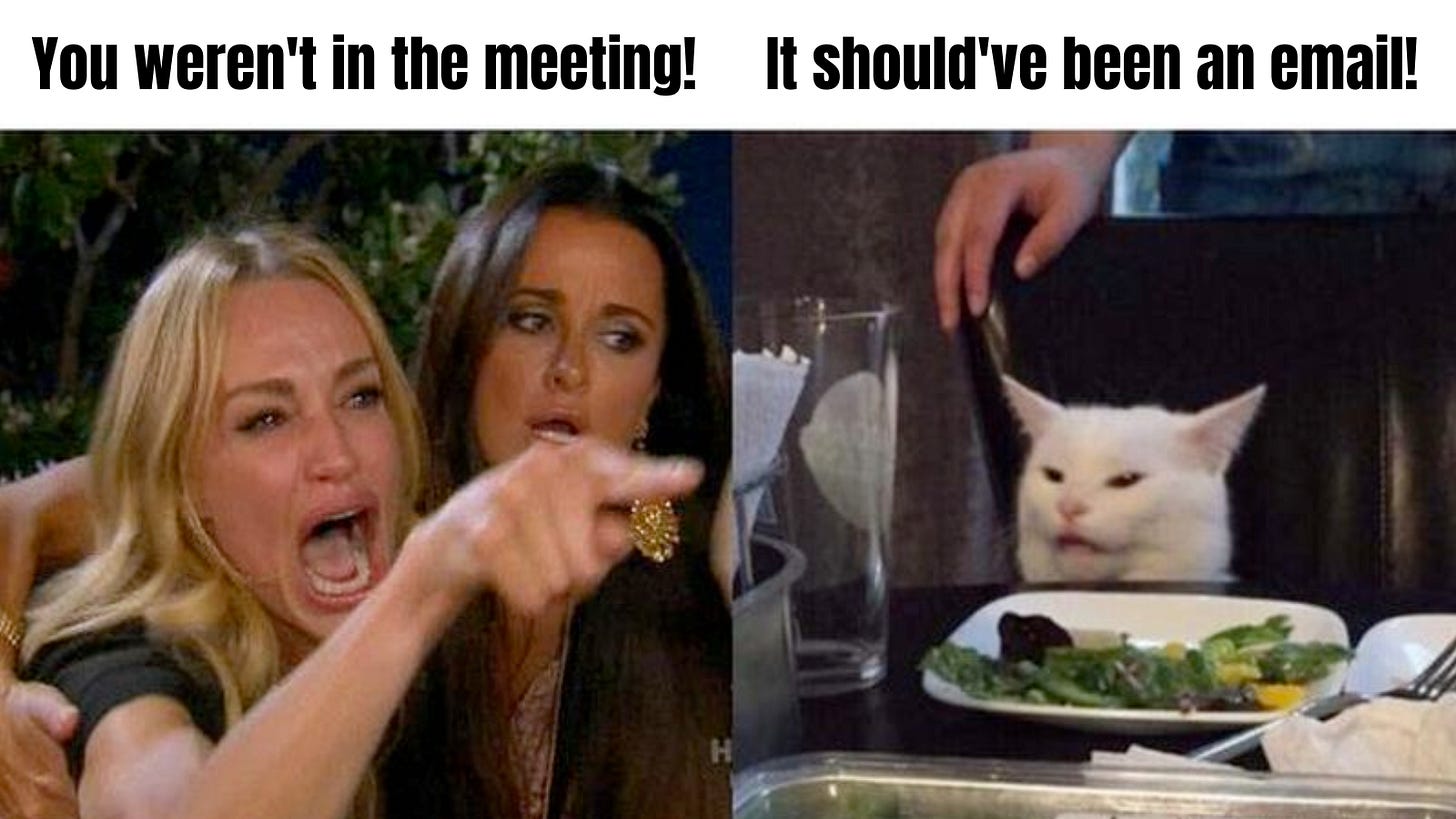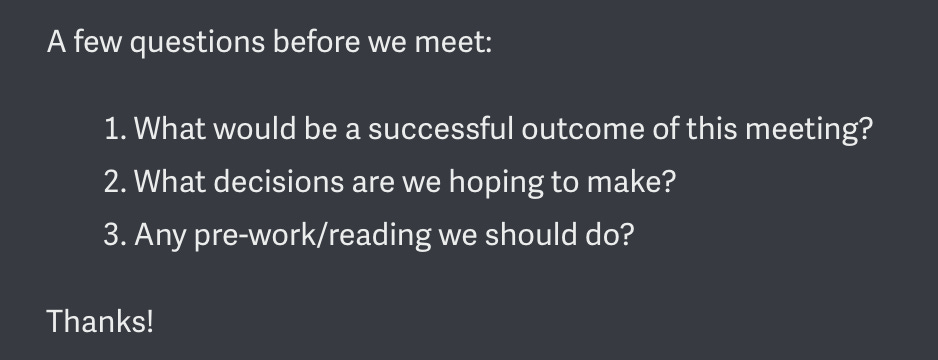10 tips to run effective meetings
Part 2: Improve the quality of your meetings
Several years ago, my husband was in a 20-person cross functional meeting at Facebook. It was scheduled for 30 minutes, and the meeting owner opened with, “Before we get started, I don’t think everyone knows each other. Can we go around a circle and say your name, team, and your relevance to this project.” After making it through a few intros, his manager stood up and interjected, “Are we really doing this?!,” and then briskly walked out of the room.
While extreme, the guy kinda had a point. 😂
Welcome to Part 2 of my meeting mini-series, with practical tips on how to run energizing, productive meetings from some of the most effective people I know.
Here’s a quick refresher on the series and what to expect:
Part 1: RESET - Structurally refreshing your meeting culture
Part 2: RUN - Tactical advice for how to run effective meetings 👈 You are here!
Part 3: DEVELOP - Tips for getting the most out of 1:1s
Let’s dive in!
What makes for a great meeting, anyway?
Looking at a calendar stacked with meetings, how does that make you feel?
Likely some of those meetings don’t need to happen. But for the ones that do, imagine feeling excited about every single one of them.
Reflecting on my own experiences with meetings, I think what separates good from terrible meetings is how you feel at the end of it. An effective meeting:
🔥 Gives you energy and makes you FIRED UP and excited for what’s next.
🤝 Makes you feel closer and more connected to others and your team.
✅ Helps you feel productive, engaged, and like you’re making great progress.
So how do we get to that end state?
It all starts with prep
🌶 Personal hot take — meetings with inadequate prep are destined to fail. Great clarity leads to great outcomes, and clarity requires prep work.
Here’s how to set the foundation for highly effective meetings:
Tip #1: Start with the basics — know your intended purpose, and set the agenda in advance
Setting a clear intention of the meeting goal and expectations for everyone is crucial. As Lauren Zion, VP of Business Operations and Analytics at Socure advised, “In general, I think the key to making meetings more productive is to be very specific about the purpose of the meeting, even if it's a brainstorm or inform type meeting.” Zion continues, “If there is a significant amount of background information needed to make a decision or have an informed discussion, I highly encourage sending pre-reads well ahead of time and including this information in the calendar invites along with a specific agenda.”
As another way to quickly indicate meeting purpose, Laura Vang, our head of product, has recently started using a prefix like [JAM] or [DECIDE] in front of meeting names. The visual distinction of those labels has been personally helpful for knowing what to expect when quickly scanning a calendar for the day.
Tip #2: If the meeting purpose isn’t clear, cancel it or ask the meeting owner for more clarity
Don’t be afraid to cancel meetings without agendas. One of Zion’s tips is “to simply cancel the meeting and replace it with a written update or ask the meeting owner for clarity” if the meeting purpose isn’t clear or the synchronous review doesn't seem completely necessary.
In the spirit of doing better at this, I recently created an email template to respond to meeting invites that don’t have an attached agenda:
Though I’ve only had to use it a few times so far, I’ve been impressed with the clarity these few questions have provided! And in other cases, these questions have prompted meetings to be canceled in favor of more async comms or further research.
Tip #3: For recurring meetings, keep the format consistent
Sarah Hinkfuss, Partner at Bain Capital Ventures, encourages keeping to a reliable format for recurring meetings. “Have a structure and stick to it. When people know what to expect, they come prepared.” What I also love about this advice is that it reduces cognitive overload in decision-making — with each meeting, people aren’t fumbling to recreate the wheel, because there’s already a set agenda in place.
Similarly, rituals can drive intended behaviors. For example, my husband has a personal meeting rule of giving people a 3 minute grace period before plowing ahead and getting started. Everyone who works with him knows about the 3 minute rule, and it encourages them to show up on time so they don’t miss out.
Tip #4: Curate your attendee list and avoid attendee bloat
The meetings I get the most energy from are the ones where all the participants are actively engaged. On the flip side, I’ve struggled in meetings where it’s clear that the content isn’t relevant to everyone in attendance and therefore people’s attention and energy wanes.
As a solve for this, Hannah Baker, VP of Operations at Magoosh, recommends being “extremely intentional about the invitee list.” She says, “Make sure that everyone critical is in the room, and that everyone in the room is critical. Attendees should be both adding value to the meeting, and getting value from it.”
“If someone only needs to listen and isn't expected to contribute, share a recording or notes instead of having them join live. Attendee "bloat" can be a real killer of meeting functionality!”
I wholeheartedly endorse this, both for my own meetings, as well as the ones I’m invited to. I have a regular practice of auditing my calendar 1-2 days in advance, reviewing the agenda and attendee list, and then confirming whether my presence (or that of others) is actually needed.
Rituals for running effective meetings
So you’ve done the prep, and the right people are there. What’s next?
Tip #5: Start with a quick check-in
In a distributed, remote-first culture, it’s very easy to hurtle from meeting to meeting and not have as much time to check-in with people. Water cooler opportunities aren’t as easy to come by, and that’s why it can be especially important to have a ritual of checking in with each other to level-set, see how everyone’s doing, and build trust within the organization.
David Clavens, startup advisor and former VP of Marketing at Aalto and Scoop recommends doing a quick, structured check-in to kick-off team meetings and help everyone get more context on their current headspace. “We started leadership meetings with a red/yellow/green that was personal and professional. For example, ‘Professionally I’m green because I’m excited about the next project, but personally I’m yellow because my kid kept me up all last night and I’m kinda tired.’” He says, “With this, you can understand the energy of people when they walk into the room, which is distinctly different from ‘Wow, Bob’s in a bad mood.’”
Tip #6: For recurring meetings, report out on prior to-do’s with “done” or “not done.”
In general, I’m a big fan of sharing status updates async. However, I recently read the book Traction, by Gino Wickman, and particularly loved his recommendation to review any action items from the last meeting and only allow for two outcomes: done or not done. Having the reporting be so binary serves two purposes:
It makes for a snappy, efficient update, and
It eliminates any excuses (“I wanted to but…,” “I’m waiting for a response…”)
This is a great first step in fostering a culture of accountability and execution.
Tip #7: Try an off-topic “parking lot” to keep meetings on track
Whomever is running the meeting should also be in charge of moderating the meeting, moving the conversation along from topic to topic, and ensuring the meeting is achieving its stated purpose.
This can be easier said than done, especially for complex topics where it’s easy to rabbit-hole into tangential topics. One idea for how to keep people on track is through “parking” off-topic ideas in a visual parking lot. Clavens had some advice here too, “At the beginning of a meeting, I’d say ‘Hey, there are going to be a lot of ideas generated today. As other topics come up, we’ll put them in a parking lot and come back to them later.” He continued, “The parking lot visual made it easy for people to feel like their ideas were valid and heard, but also didn’t derail meetings from their intended purpose.”
In a remote context, I’ve started creating a parking lot section of shared notes docs, so that it’s easy to return to topics down the road. It also gives me a head start on building future agendas.
Tip #8: End every meeting with capturing tasks and deadlines
In the last few minutes of a meeting, someone (usually the meeting owner) should summarize the outcome of the meeting, any next steps, and the owners of those actions. Better yet, a written summary should be immediately sent over Slack or email.
This is easier said than done, especially when there isn’t a lot of time between back to back meetings. If possible, ending meetings early is a gift to everyone involved, and the extra 5-10 min gives people time to wrap things up before heading to whatever’s next.
Tip #9: Ask for instant meeting feedback
Another tip from Traction is to end every meeting with asking “How effective was this meeting?,” and then having people open their hands to share their ratings at the same time. I just started trialing this tactic this week, and am loving that it provides instant shared feedback with very little effort.
Share the knowledge
Tip #10: Send out applicable meeting readouts to a broader audience
Finally, it’s important to think through if any information would be helpful for a broader audiences’ consumption. What important decisions were made? What context do people need for continued alignment and action? Who else may need to be involved in the follow-up conversation? Tasking someone to send out the meeting readout can be an extremely efficient and effective way to catch people up to speed and eliminate meeting FOMO.
The punchline here? Run your meetings with intention and purpose, and everyone will leave with more energy and clear next steps on how to move things forward.
I’m always inspired by new ways to make meetings awesome — what other meeting tips have worked for you?
Coming up next, is Part 3: DEVELOP - Tips for getting the most out of 1:1s.


